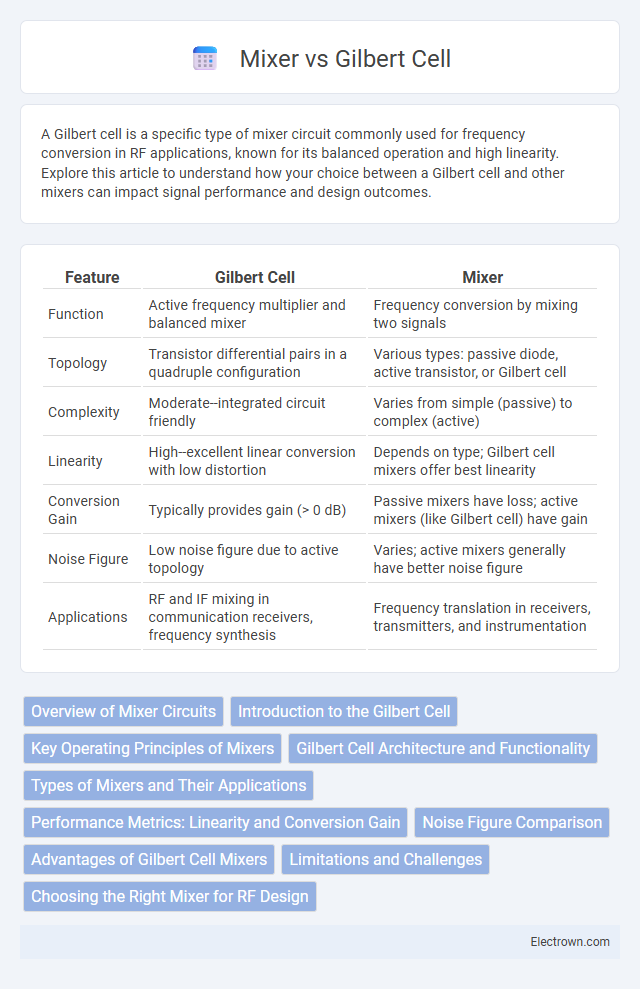A Gilbert cell is a specific type of mixer circuit commonly used for frequency conversion in RF applications, known for its balanced operation and high linearity. Explore this article to understand how your choice between a Gilbert cell and other mixers can impact signal performance and design outcomes.
Table of Comparison
| Feature | Gilbert Cell | Mixer |
|---|---|---|
| Function | Active frequency multiplier and balanced mixer | Frequency conversion by mixing two signals |
| Topology | Transistor differential pairs in a quadruple configuration | Various types: passive diode, active transistor, or Gilbert cell |
| Complexity | Moderate--integrated circuit friendly | Varies from simple (passive) to complex (active) |
| Linearity | High--excellent linear conversion with low distortion | Depends on type; Gilbert cell mixers offer best linearity |
| Conversion Gain | Typically provides gain (> 0 dB) | Passive mixers have loss; active mixers (like Gilbert cell) have gain |
| Noise Figure | Low noise figure due to active topology | Varies; active mixers generally have better noise figure |
| Applications | RF and IF mixing in communication receivers, frequency synthesis | Frequency translation in receivers, transmitters, and instrumentation |
Overview of Mixer Circuits
Mixer circuits, including Gilbert cells, are essential components in RF and communication systems used for frequency conversion by multiplying two input signals. The Gilbert cell mixer is a balanced mixer design known for its high linearity, good port-to-port isolation, and conversion gain, making it suitable for low-noise applications. Other mixer types, such as diode or passive mixers, generally offer simplicity and wide bandwidth but often sacrifice linearity and conversion gain compared to active Gilbert cell mixers.
Introduction to the Gilbert Cell
The Gilbert Cell is a specialized analog multiplier circuit widely used in RF and communication systems for frequency mixing and modulation. Unlike a conventional mixer, it employs a balanced transistor configuration to provide high linearity and better isolation between ports, enhancing signal integrity. Your designs benefit from the Gilbert Cell's ability to combine signals efficiently while minimizing distortion and noise.
Key Operating Principles of Mixers
The Gilbert Cell operates as a balanced mixer using translinear loop principles to multiply two input signals, enabling frequency conversion with high linearity and gain. Mixers in general function by heterodyning input signals, generating sum and difference frequencies through nonlinear components such as diodes or transistors. While simple mixers rely on diode switching for frequency translation, the Gilbert Cell's differential transistor configuration enhances isolation, linearity, and conversion efficiency in RF and communication circuits.
Gilbert Cell Architecture and Functionality
The Gilbert Cell is a specialized mixer architecture widely used in RF and communication systems for frequency conversion and signal modulation. It features a double-balanced configuration with transistors arranged in quadrature, enabling high linearity, low distortion, and improved isolation between ports. Your design benefits from the Gilbert Cell's ability to efficiently multiply two input signals, making it ideal for applications requiring precise analog signal processing.
Types of Mixers and Their Applications
Gilbert cells are a type of double-balanced mixer widely used in RF and microwave communication systems for frequency translation, offering high linearity and isolation between ports. Other common mixers include unbalanced mixers for simple frequency conversion, single-balanced mixers for moderate isolation improvement, and passive diode mixers favored for low noise and broadband applications. Each mixer type serves specific applications such as signal modulation, demodulation, frequency synthesis, and image rejection in wireless transceivers, radar systems, and instrumentation.
Performance Metrics: Linearity and Conversion Gain
The Gilbert Cell mixer excels in linearity due to its balanced design, minimizing distortion and intermodulation products, which is vital for high-fidelity signal processing in RF applications. Its inherent conversion gain typically ranges from 4 to 10 dB, offering amplification during the frequency translation process, enhancing overall system sensitivity. When optimizing your design for superior linearity and conversion gain, selecting a Gilbert Cell mixer over a passive mixer can significantly improve performance in demanding communication systems.
Noise Figure Comparison
The Gilbert cell exhibits a low noise figure, typically around 7-10 dB, making it highly suitable for RF applications requiring minimal signal degradation. In contrast, general mixers often have higher noise figures, typically ranging from 10-15 dB, which can adversely affect your system's overall sensitivity. Choosing a Gilbert cell over a conventional mixer can significantly improve noise performance in communication receivers.
Advantages of Gilbert Cell Mixers
Gilbert Cell mixers offer superior linearity and high gain compared to traditional mixers, making them ideal for RF and communication applications where signal integrity is crucial. Their balanced design reduces distortion and improves isolation between ports, enhancing overall performance in complex signal processing. You benefit from improved dynamic range and reduced noise figure, which ensures cleaner signal conversion in your communication systems.
Limitations and Challenges
Gilbert cells face limitations such as nonlinear distortion and higher power consumption compared to passive mixers, impacting signal fidelity in high-frequency applications. Passive mixers offer low noise and linearity but suffer from conversion loss and limited gain, reducing overall system sensitivity. Your choice between these two depends on balancing trade-offs in complexity, power efficiency, and signal quality requirements.
Choosing the Right Mixer for RF Design
Selecting the ideal mixer for RF design hinges on the application's linearity, noise figure, and conversion gain requirements, where the Gilbert Cell mixer excels due to its balanced structure and superior intermodulation distortion performance. Unlike passive mixers, Gilbert Cell mixers provide active mixing with built-in gain, making them suitable for low-signal environments demanding high sensitivity and dynamic range. Designers prioritize Gilbert Cell topologies in complex RF systems like receivers and transceivers to optimize signal integrity while balancing power consumption and integration complexity.
Gilbert Cell vs Mixer Infographic

 electrown.com
electrown.com